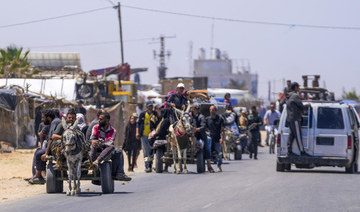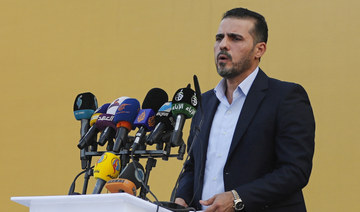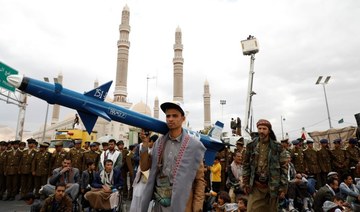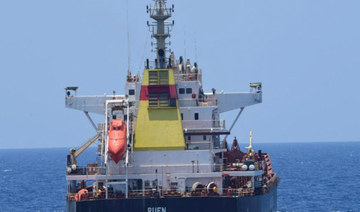GAZA CITY, Gaza Strip: Israeli troops pushed deeper into Gaza on Friday to destroy rocket launching sites and tunnels, firing volleys of tank shells and clashing with Palestinian fighters in a high-stakes ground offensive meant to weaken the enclave’s Hamas rulers.
Israel launched the operation late Thursday, following a 10-day campaign of more than 2,000 air strikes against Gaza that had failed to halt relentless Hamas rocket fire on Israeli cities.
Israel’s first major ground offensive in Gaza in just over five years came as Egyptian cease-fire efforts stalled. Earlier this week, Israel accepted Cairo’s offer to halt hostilities, but Hamas refused, demanding that Israel and Egypt first give guarantees to ease the blockade on Gaza.
Israel had been reticent about launching a ground offensive for fear of endangering its own soldiers and drawing international condemnation over mounting Palestinian civilian deaths.
But after thousands of troops had been on standby for several days, Israeli Prime Minister Benjamin Netanyahu said he had ordered the military to prepare for a “significant expansion” of the ground offensive.
“Since it is not possible to deal with the tunnels only from the air, our soldiers are doing it also from the ground,” he said before a special Cabinet meeting in Tel Aviv.
“We chose to begin this operation after the other options were exhausted and with the understanding that without the operation the price we will pay can be very high.”
Throughout the night, the thud of tank shells echoed across Gaza, often just a few seconds apart. Several explosions from Israeli missile strikes shook high-rise buildings in central Gaza City and sent pillars of smoke into the sky.
The wounded were rushed to Gaza’s main Shifa Hospital, including several members of the same family struck by shrapnel from tank shells. Among those hurt were a toddler and a boy of elementary school age, their bodies pocked by small bloody wounds.
Gaza health officials said at least 20 Palestinians have been killed since the ground operation began, including three teenage siblings killed by shrapnel from a tank shell attack. At the morgue, one of the victim’s faces was blackened by soot and he and his siblings were each wrapped in a white burial shroud.
The Israeli military said it killed 17 militants in different exchanges of fire, while 13 were captured after surrendering. It was not immediately clear if the militants were among the casualties reported by Gaza authorities.
“The ground offensive does not scare us and we pledge to drown the occupation army in Gaza mud,” Hamas spokesman Sami Abu Zuhri said in a statement.
The Israeli military said one soldier was killed in the northern Gaza Strip, the first Israeli casualty among troops. The circumstances behind the death of Staff Sgt. Eitan Barak, 20, were not immediately clear, with Hamas’ military wing saying it ambushed Israeli units in the northern town of Beit Lahiya and caused casualties but Israeli media saying it was likely a case of friendly fire.
Israel’s chief military spokesman Brig. Gen. Moti Almoz told Army Radio the military was investigating the circumstances behind the soldier’s death.
Tanks, infantry and engineering forces were operating inside the coastal strip. The military said it targeted rocket launchers, tunnels and more than 100 other targets, and that a number of soldiers were wounded throughout the night.
Israeli officials have said the goal is to weaken Hamas militarily and have not addressed the possibility of driving the Islamic militants from power.
However, Hamas has survived Israeli offensives in the past, including a major three-week ground operation in January 2009 from which it emerged militarily weaker, but then recovered. Hamas has since assembled thousands of rockets and built a system of underground bunkers.
Since the July 8 start of the air campaign, more than 260 Palestinians have been killed and more than 2,000 wounded, Palestinian health officials said. In Israel, one civilian died and several were wounded.
Israeli public opinion appears to strongly support the offensive after days of unrelenting rocket fire from Gaza and years of southern Israeli residents living under the threat. Gaza militants have fired more than 1,500 rockets at Israel over the past 11 days.
Israel said it launched an open-ended assault on several fronts, with the primary aim being to destroy underground tunnels into Israel built by Hamas that could be used to carry out attacks.
On Thursday, 13 heavily armed Hamas militants tried to sneak in through such a tunnel, but were stopped by an airstrike after they emerged some 250 meters (820 feet) inside Israel.
Israeli defense officials said soldiers faced little resistance during the first night of the ground operation, but the longer troops remain in Gaza, the greater the risk for heavy casualties on both sides.
Forces are expected to spend a day or two staking out positions in the north, east and south of the Gaza Strip before moving to the second phase, which is to destroy tunnels, an operation that could take up to two weeks.
Once Hamas is able to study the military’s positions and movements, it may push back more forcefully, the officials said.
The officials spoke on condition of anonymity because they were not authorized to discuss the military’s strategy.
“The mission is progressing well,” said Lt. Gen. Benny Gantz, Israel’s military chief. “There were a number of incidents overnight that we overcame and moved forward.”
Prior to the Israeli Cabinet meeting, several ministers said they expected a prolonged offensive.
“We need to go in and finish the job. We need to eliminate every terrorist. They have no immunity.” said Uri Ariel, a Cabinet minister from the hard-line Jewish Home party.
Meanwhile, Egypt continued its efforts to get the Palestinians factions to agree to its truce proposal. Palestinian President Mahmoud Abbas told reporters on Friday in Cairo that while the ground offensive complicated matters he met with the Islamic Jihad leadership and “found a kind of acceptance of this initiative and readiness to convince others to accept it.” Islamic Jihad, a smaller militant faction in Gaza, says it is open to the proposal but not in its current form.
French Foreign Minister Laurent Fabius was traveling Friday to Egypt, Jordan and Israel as part of a diplomatic push to stop the fighting in Gaza.
He said in a statement that he wants a cease-fire and lasting truce “that responds to Israel’s security needs and Palestinian economic needs.” He also urged Israel to show “restraint.”
Israel deepens Gaza push to destroy Hamas tunnels
Israel deepens Gaza push to destroy Hamas tunnels

Israel orders new evacuations in Rafah as it prepares to expand operations

- Fighting is escalating across the enclave with heavy clashes between Israeli troops and Palestinian militants
- Israel’s move into Rafah has so far been short of the full-scale invasion that it has planned
RAFAH, Gaza Strip: Israel ordered new evacuations in Gaza’s southern city of Rafah on Saturday as it prepared to expand its operation, saying it was also moving into an area in northern Gaza where Hamas has regrouped.
Fighting is escalating across the enclave with heavy clashes between Israeli troops and Palestinian militants on the outskirts of Rafah, leaving the crucial nearby aid crossings inaccessible and forcing more than 110,000 people to flee north.
Israel’s move into Rafah has so far been short of the full-scale invasion that it has planned.
The United Nations and other agencies have warned for weeks that an Israeli assault on Rafah, which borders Egypt near the main aid entry points, would cripple humanitarian operations and cause a disastrous surge in civilian casualties. More than 1.4 million Palestinians — half of Gaza’s population— have been sheltering in Rafah, most after fleeing Israel’s offensives elsewhere.
Army spokesman, Avichay Adraee, told Palestinians in Jabaliya and Beit Lahiya cities and the surrounding areas to leave their homes and head to shelters in the west of Gaza City, warning that people were in “a dangerous combat zone” and that Israel was going to strike with “great force.”
Heavy fighting is underway in northern Gaza, where Hamas appeared to have once again regrouped in an area where Israel has already launched punishing assaults. Battles erupted this week in the Zeitoun area on the outskirts of Gaza City, in the northern part of the territory. Northern Gaza was the first target of the ground offensive. Israel said late last year that it had mostly dismantled Hamas in the area.
At least 19 people, including eight women and eight children, were killed overnight in Central Gaza in three different strikes that hit the towns of Zawaida, Maghazi and Deir al Balah, according to Al Aqsa Martyrs Hospital in Deir al Balah and an Associated Press journalist who counted the bodies.
Israel’s bombardment and ground offensives in Gaza have killed more than 34,800 Palestinians, mostly women and children, according to the Gaza Health Ministry, which does not distinguish between civilians and combatants in its figures. Much of Gaza has been destroyed and some 80 percent of Gaza’s population has been driven from their homes.
Hamas says Gaza ceasefire efforts are back at square one

- Israel has killed more than 34,700 Palestinians, according to Gaza’s Health Ministry
CAIRO: The Palestinian militant group Hamas said on Friday that efforts to find a Gaza Strip truce deal were back at square one after Israel effectively spurned a plan from international mediators, and the White House said it was trying to keep the sides engaged “if only virtually.”
Hamas said in a statement it would consult with other Palestinian factions on its strategy for talks to halt seven months of war triggered by its deadly Oct. 7 attack on Israel.
Hours earlier, the United Nations warned that aid for Gaza could grind to a halt in days after Israel seized control this week of the Rafah crossing between Gaza and Egypt, a vital route for supplies to the devastated Palestinian enclave.
Despite heavy US pressure, Israel has said it will proceed with an assault on the southern Gaza city of Rafah, where more than 1 million displaced people have sought refuge and Israeli forces say Hamas militants are dug in.
Israeli tanks captured the main road dividing the eastern and western sections of Rafah, effectively encircling the eastern part of the city in an assault that has caused Washington to hold up delivery of some military aid.
The White House said that it was watching “with concern,” but the Israeli operations appeared to be localized around the shuttered Rafah crossing and did not reflect a large-scale invasion.
“Once again, we urge the Israelis to open up that crossing to humanitarian assistance immediately,” said White House national security spokesman John Kirby.
Israel’s plan for an all-out assault on Rafah has ignited one of the biggest rifts in generations with its main ally. Washington held up a weapons shipment over fears of massive civilian casualties.
In a report to Congress, President Joe Biden’s administration on Friday said it was reasonable to assess that Israel had used US arms in instances “inconsistent” with international humanitarian law.
However, the administration said it still found credible and reliable Israel’s assurances that it will use US weapons in accordance with international humanitarian law.
Indirect diplomacy has failed to end a war that health authorities in Hamas-run Gaza say has killed almost 35,000 people since the Oct. 7 attack. Some 1,200 people were killed in Israel and 253 taken hostage on Oct. 7, according to Israeli tallies.
Ceasefire talks in Cairo broke up on Thursday with no agreement.
Hamas had said it agreed at the start of the week to a proposal by Qatari and Egyptian mediators that had previously been accepted by Israel. Israel said the Hamas proposal contained elements it cannot accept.
“Israel’s rejection of the mediators’ proposal through the amendments it made returned things to the first square,” Hamas said in Friday’s statement.
“In the light of (Israel Prime Minister Benjamin) Netanyahu’s behavior and rejection of the mediators’ document and the attack on Rafah and the occupation of the crossing, the leadership of the movement will hold consultations with the brotherly leaders of the Palestinian factions to review our negotiation strategy.”
“Hamas did not suspend nor withdraw from the negotiations; the occupation (Israelis) turned against the mediators’ proposal,” a senior Hamas official, Khalil Al-Hayya, said in comments to Al Araby TV published by Hamas.
Kirby said the end of the talks — which CIA Director William Burns was helping mediate — was “deeply regrettable,” but the US believed the differences were surmountable.
“We are working hard to keep both sides engaged in continuing the discussion, if only virtually,” he said.
EXPLOSIONS AND GUNFIRE
Residents described almost constant explosions and gunfire east and northeast of Rafah on Friday, with intense fighting between Israeli forces and militants from Hamas and Islamic Jihad.
Hamas said it ambushed Israeli tanks near a mosque in the east of the city, a sign the Israelis had penetrated several kilometers from the east to the outskirts of the built-up area.
Israel has ordered civilians out of the eastern part of Rafah, forcing tens of thousands of people to seek shelter outside the city, previously the last refuge of more than a million who fled other parts of the enclave during the war.
Israel says it cannot win the war without assaulting Rafah to root out thousands of Hamas fighters it believes are sheltering there. Hamas says it will fight to defend it.
Supplies were already running short and aid operations could halt within days as fuel and food stocks get used up, UN aid agencies said.
“For five days, no fuel and virtually no humanitarian aid entered the Gaza Strip, and we are scraping the bottom of the barrel,” said the UNICEF Senior Emergency Coordinator in the Gaza Strip, Hamish Young.
Aid agencies say the battle has threatened hundreds of thousands of displaced civilians.
“It is not safe, all of Rafah isn’t safe, as tank shells landed everywhere since yesterday,” Abu Hassan, 50, a resident of Tel Al-Sultan west of Rafah told Reuters via a chat app.
“I am trying to leave but I can’t afford 2,000 shekels ($540) to buy a tent for my family,” he said. “There is an increased movement of people out of Rafah even from the western areas, though they were not designated as red zones by the occupation.”
Israeli tanks have sealed off eastern Rafah from the south, capturing and shutting the only crossing between the enclave and Egypt. An advance on Friday to the Salahuddin road that bisects the Gaza Strip completed the encirclement of the “red zone” where they have ordered residents out.
The Israeli military said its forces in eastern Rafah had located several tunnel shafts, and troops backed by an air strike fought at close quarters with groups of Hamas fighters, killing several.
It said Israeli jets had hit several sites from which rockets and mortar bombs had been fired toward Israel.
The UN General Assembly overwhelmingly backed a Palestinian bid to become a full UN member by recognizing it as qualified to join and recommending the UN Security Council “reconsider the matter favorably.”
Iranians vote in parliamentary runoff election

- Politicians calling for change in the country’s government, known broadly as reformists, were generally barred from running in the election
TEHRAN: Iranians voted on Friday in a runoff election for the remaining seats in the country’s parliament after hard-line politicians dominated March balloting.
People in 22 constituencies across the country will elect 45 representatives from a pool of 90 candidates, 15 of whom are considered moderate.
In the capital, Tehran, 16 representatives will be chosen from 32 candidates, all hard-liners.
Final results are expected on Monday, though counts in smaller constituencies are likely before that.
Iran’s parliament plays a secondary role in governing the country.
Supreme Leader Ali Khamenei has the final say in all important state matters.
State TV showed Khamenei voting on Friday immediately after the polls opened.
He urged people to vote and said the runoff election was as important as the main one.
In the March election, hard-liners won 200 out of 245 seats, with more moderate candidates taking the other 45. A total of 25 million ballots were cast, for a turnout of just under 41 percent.
The previous lowest turnout was 42 percent in the 2020 parliamentary election.
Politicians calling for change in the country’s government, known broadly as reformists, were generally barred from running in the election.
Those calling for radical reforms or for abandoning Iran’s theocratic system were also banned or did not bother to register as candidates.
Suspected pirate attack in Gulf of Aden raises concerns about growing Somali piracy

- Somali piracy in the region at the time cost the world’s economy some $7 billion — with $160 million paid out in ransoms, according to the Oceans Beyond Piracy monitoring group
DUBAI: A European naval force detained six suspected pirates on Friday after they opened fire on an oil tanker traveling through the Gulf of Aden, officials said, likely part of a growing number of piracy attacks emanating from Somalia.
The attack on the Marshall Islands-flagged Chrystal Arctic comes as Houthis have also been attacking ships traveling through the crucial waterway, the Red Sea, and the Bab Al-Mandeb Strait connecting them.
The assaults have slowed commercial traffic through the key maritime route onward to the Suez Canal and the Mediterranean Sea.
The pirates shot at the tanker from a small ship “carrying weapons and ladders,” according to the British military’s UK Maritime Trade Operations Center, which oversees Mideast shipping routes.
The pirates opened fire first at the Chrystal Arctic, whose armed onboard security team returned fire at them, the UKMTO said.
BACKGROUND
Maritime sources say pirates may be encouraged by a relaxation of security or may be taking advantage of the chaos caused by attacks on shipping by the Houthis.
The pirates then abandoned their attempt to take the tanker, which continued on its way with all its crew safe, the UKMTO said.
Hours later, the EU naval force in the region known as Operation Atalanta said a frigate operating in the region detained six suspected pirates.
The frigate seized the pirates, given “the unsafe condition of their skiff” and said that some had “injuries of varied severity.”
It was not immediately clear if those injured suffered gunshot wounds from the exchange of fire with the Chrystal Arctic.
The EU force declined to elaborate “due to the security of the operations.”
Once-rampant piracy off the Somali coast diminished after a peak in 2011. That year, there were 237 reported attacks in waters off Somalia.
Somali piracy in the region at the time cost the world’s economy some $7 billion — with $160 million paid out in ransoms, according to the Oceans Beyond Piracy monitoring group.
Increased naval patrols, a strengthening central government in Mogadishu, Somalia’s capital, and other efforts saw the piracy beaten back.
However, concerns about new attacks have grown in recent months.
According to the International Maritime Bureau, five incidents were reported off Somalia in the first quarter of 2024.
“These incidents were attributed to Somali pirates who demonstrate mounting capabilities, targeting vessels at great distances from the Somali coast,” the bureau warned in April.
It added that there had been “several reported hijacked dhows and fishing vessels, which are ideal mother ships to launch attacks at distances from the Somali coastline.”
In March, the Indian navy detained dozens of pirates who seized a bulk carrier and took its 17 crew hostage.
In April, pirates release 23 crew members of the Bangladesh-flagged cargo carrier MV Abdullah after seizing the vessel.
The terms of the release are not immediately known.
These attacks come as the Houthi campaign has targeted shipping since November as part of their pressure campaign to stop the Israel-Hamas war raging in the Gaza Strip.
Israeli troops drive further into Rafah as tanks split city in two

- Four Israeli soldiers killed as Hamas and Islamic Jihad put up a fierce resistance
- Israel’s move into Rafah has been short of the full-scale invasion that it threatened
JEDDAH: Israeli troops pushed further into Rafah in southern Gaza on Friday as its tanks split the city in two and encircled the eastern half.
The Israeli forces faced fierce resistance from Hamas and Islamic Jihad fighters, and battles also resumed in northern Gaza, where Hamas has regrouped after being forced out earlier in the war. Four Israeli soldiers were killed in fighting there.
Israel’s move into Rafah has been short of the full-scale invasion that it threatened. The US and other Israeli allies are deeply opposed to a major offensive, and Washington has threatened to hold back arms to shipments to Israel.
But the heavy fighting has shaken the city and spread fear that a bigger assault is coming.
The UN agency for Palestinian refugees said more than 110,000 people had fled Rafah, and families who had already moved numerous times during the war were doing so again.
“The full invasion hasn’t started and things have already gotten below zero,” said Raed Al-Fayomi, a refugee in Rafah. “There’s no food or water.”
Those fleeing erected new tent camps in Khan Younis, which was half destroyed in an earlier Israeli offensive, and the town of Deir Al-Balah.
The charity Project Hope said there had been a surge in people from Rafah seeking care for blast injuries, infections and pregnancies in its clinic in Deir Al-Balah.
“People are evacuating to nothing. There are no homes or proper shelters for people to go to,” said the group’s Gaza team leader in Rafah, Moses Kondowe.

UN aid official Georgios Petropoulos said humanitarian workers had no supplies to set up in new locations.
“We simply have no tents, we have no blankets, no bedding, none of the items that you would expect a population on the move to be able to get from the humanitarian system,” he said.
The fighting in Rafah has left crucial nearby aid crossings inaccessible, and food and other supplies were running critically low, aid agencies said.
The World Food Program will run out of food for distribution in southern Gaza by Saturday, Petropoulos said.
Aid groups have said fuel will also be depleted soon, forcing hospitals to shut down critical operations and bringing to a halt trucks delivering aid across south and central Gaza.

















